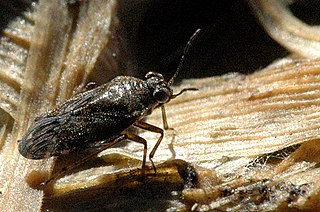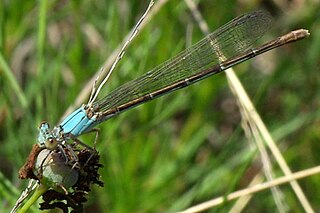
Rhynchobdellida, the jawless leeches or freshwater leeches, are an order of aquatic leeches. Despite the common name "freshwater leeches", species are found in both sea and fresh water. They are defined by the presence of a protrusible proboscis instead of jaws, and having colourless blood. They move by "inchworming" and are found worldwide. The order contains 110 species, divided into 41 genera and three families. Members of the order range widely in length, usually between 7 and 40 mm. They are hermaphrodite. The order is not monophyletic.

Leptopodomorpha is an infraorder of insects in the order Hemiptera. Leptopodomorpha is an infraorder of the order Heteroptera that contains more than 380 species. These small insects are also called shore bugs, or spiny shore bugs. As their name suggests, shore bugs range from being intertidal, to living near streams and lakes. Four families belong to this infraorder, the largest of which is Saldidae with about 350 species, compared to about 30 in Leptopodidae, and only 5 and 1 in Omaniidae and Aepophilidae respectively. Saldidae are known in particular for their jumping ability.
Erpobdella obscura is a freshwater ribbon leech common in North America. It is a relatively large leech and is commonly used as bait by anglers for walleye and other sport fish. In Minnesota, live bait dealers annually harvest over 45,000 kg of bait-leeches, raising concerns of over-harvest.

Anisus vorticulus is a species of minute, air-breathing, freshwater snail, an aquatic gastropod mollusk in the family Planorbidae, the ramshorn snails.
Smicrideinae is one of five subfamilies in the family Hydropsychidae of net-spinning caddisflies.

Saldidae, also known as shore bugs, are a family of insects in the order Hemiptera. They are oval-shaped and measure 2–8 mm (0.08–0.31 in) when mature. Typically they are found near shorelines or the marginal growths near freshwater bodies, estuaries, and sea coasts. They can flee by leaping or taking flight. There are about 350 recognized species with the majority from the Nearctic and Palearctic. Many species are found in the intertidal zone and both adults and nymphs of some species like Saldula pallipes can tolerate submergence at high-tide. Saldidae are predators and scavengers. They pass the winter through egg or adult diapause.

The powdered dancer is a damselfly of the family Coenagrionidae. It is native to North America. It may be seen year-round in at least some of its range.

The Hypsibiidae are a family of water bears or moss piglets, tardigrades in the class Eutardigrada.
Prostoma jenningsi is a species of ribbon worm known only from one site near Croston, Lancashire. It was described in 1971, and is believed to be the county's only endemic species. It grows up to 20 mm (0.8 in) long, with 4–6 black eyespots, and has a long eversible proboscis.
Prostoma is a genus of freshwater nemerteans, containing the following species:

Branchiobdellida is an order of freshwater leech-like clitellates that are obligate ectosymbionts or ectoparasites, mostly of astacoidean crayfish. They are found in the Northern Hemisphere and have a holarctic distribution in East Asia, the Euro-Mediterranean region and North and Central America, with the greatest species diversity being in North and Central America.

Crustaceans belong to the subphylum Crustacea, and form a large, diverse group of arthropods including decapods, seed shrimp, branchiopods, fish lice, krill, remipedes, isopods, barnacles, copepods, opossum shrimps, amphipods and mantis shrimp. The crustacean group can be treated as a subphylum under the clade Mandibulata. It is now well accepted that the hexapods emerged deep in the Crustacean group, with the completed group referred to as Pancrustacea. The three classes Cephalocarida, Branchiopoda and Remipedia are more closely related to the hexapods than they are to any of the other crustaceans.
Echiniscoides sigismundi is a species of marine tardigrade. It lives in seaweeds or plates of barnacles, or more generally in algal strongholds in inter-tidal areas.

Cordulegaster bidentata, also known as sombre goldenring or two-toothed goldenring, is a species of dragonfly in the family Cordulegastridae.
Ramellogammarus similimanus is a crustacean species in the family Anisogammaridae. Because this amphipod only resides in the Portland metropolitan area, in Oregon, United States, it has been given the common name "Stumptown scud."

Theromyzon tessulatum is a species of leech in the family Glossiphoniidae. It is a haematophagous (blood-sucking) leech, found in freshwater habitats in Europe.

Barbronia weberi is a species of predatory freshwater leech in the family Salifidae. It is native to southeastern Asia but has spread to other parts of the world, including Australia, South America, southern Europe and the United States.
Prostoma eilhardi is a species of ribbon worm. This species uses ciliary gliding to get from place to place. It is closely related to Prostoma graecense. The species has been classified as androdioecious.
Leptestheria compleximanus is a species of North American clam shrimp known by the common name playa clam shrimp or spineynose clam shrimp.
Himalayapotamon atkinsonianum is a species of freshwater crab in the family Potamidae. It is found in Nepal and parts of Northeastern India. It can be distinguished from other related species by the morphology of its gonopods.










